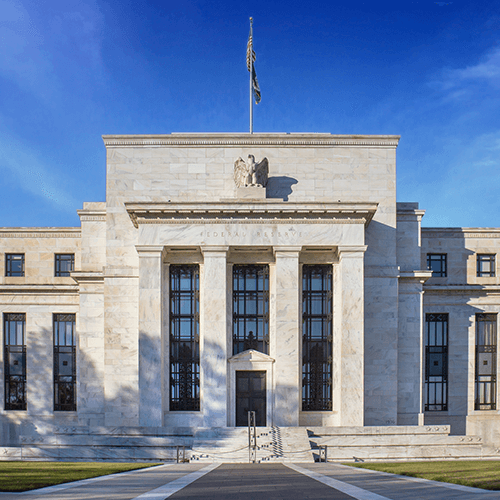
July 2025
Mid-Year Analysis — What Happened and What’s Ahead
Insights into how 2025 is unfolding and what lies ahead, opportunities in fixed income, market action, and Fed moves.
Download PDFWe recently sat down with Dominic Nolan, CEO of Aristotle Pacific Capital, to get his insights into what’s happened in the markets and economy so far in 2025 and what may lie ahead, the Fed’s next moves, and opportunities in fixed income. We finished with a random round of questions and personal reflection.
Market Performance

June was a great month in the markets. What happened?
I think many of the tail risks—primarily tariffs, taxes and geopolitical tensions—have been muted. On the tariff front, there was more clarity as certain countries made progress on deals, especially after the de-escalation of tariff rates with China and other major trading partners. Second, the Trump tax bill—known as the One Big Beautiful Bill Act—was passed. That was a major part of the new administration’s agenda. And finally, there’s been a lessening of tensions in the Middle East. It was only a few weeks ago that people were worried about an expansive war, and the term “nuclear” was being used in some headlines. I believe what we saw in June was a relief rally.
The S&P 500 Index is up 6.2% year to date, and the market is generally doing well. The Russell 1000 Growth Index is up about the same amount (6.4%) on the heels of a strong June. The S&P 500 Equal Weight Index is trailing the S&P for the year by about 1.25%, and the Russell 2000 Value Index is still a laggard, down over -3% for the year.
And fixed income?
We have seen above-coupon returns. Last month, bonds were generally up 1 to 2%; for the year, they’re up 4 to 5%, depending on the asset class. Treasury rates are down about a quarter percent on the long end of the curve. In general, balanced portfolios are up about 5% thus far in 2025.
Mag 7

How about the Magnificent 7?
June was a solid month for the Mag 7, except for Tesla, which was down 8.3%. One interesting note about the Mag 7’s performance is that you can see AI enthusiasm is in full force. NVIDIA, for instance, just became the first company to cross $4 trillion market cap.
U.S. Treasury Yield Curve

U.S. Treasury yields fell across intermediate and long maturities in June. Any thoughts on what drove the move lower?
One, inflation is trending lower than was expected at the beginning of the year. For the trailing 12 months, inflation now stands at 2.4%. I believe there’s room now for the Federal Reserve to cut interest rates if warranted. Now the Fed has stated that tariff clarity needs to take place before any cuts, but I think we’re headed in that direction. Also, we’re experiencing a soft patch in the economy which is why I think we’ve seen Treasury rates come off a bit. Keep in mind this is all on the margin.
Fed Futures

June’s FOMC meeting concluded with no change in the fed funds rate and an updated dot plot showing two cuts expected this year. Does the market agree?
The market is at an all-time high, so the short answer is yes, the market is just fine with where the Fed is.
Economic Dashboard

What’s the current data telling us about the U.S. economy?
After a negative print in the first quarter, GDP is now expected to end in positive territory for the second quarter with the Atlanta Fed GDPNow predicting it to finish at 2.5%. Inflation is at 2.4%, which is a good number. I’d categorize the jobs market as resilient. Consumer confidence is bouncing around and probably the most concerning economic indicator but not alarming. For me, the data is signaling the economy is slowing but still healthy. I think with the tax benefits coming online next year from the recently passed One Big Beautiful Bill Act, the economy will likely be stronger in 2026.
6 Months of Headlines and Volatility

For investors, what lessons can be learned from the past six months of volatility?
Don’t panic amid the volatility, which can be easier said than done. If you just kept a buy-and-hold approach, you’d likely have done well since the S&P 500 Index has returned over 6%. After “Liberation Day” on April 2 when President Trump announced a slate of tariffs, the stock market plummeted and was down 15% for the year. But since then, it’s rallied over 20%.
How has Trump changed the game for the market?
This year’s volatility gives you a sense of the impact that expanded presidential executive powers—along with a compliant Congress—can have on the economy and markets.
Mid-Year Analysis: One Big Beautiful Bill

Thoughts on the One Big Beautiful Bill Act?
The bill permanently extends the 2017 tax cuts—that’s the bulk of the bill. If it didn’t pass, there would have been substantial tax increases next year. In addition, the bill provides taxpayers larger state and local tax deductions. It also eliminated taxes on tips and overtime up to a certain amount, plus an auto-loan interest deduction for loans on U.S.-assembled vehicles—which aligns with Trump’s “America First” theme. These are mostly consumer and jobs based tax breaks that I think have been underreported.
On the business side, I think one of the most significant parts of the bill allows investors to immediately deduct 100% of the expense for business properties, in particular industrial manufacturing, instead of amortizing it over years. That should incentivize industrial investment in U.S. manufacturing. It’s a monster tax incentive for companies in my opinion.
Mid-Year Analysis: 5&P 500: Year-end Forecasts for 2025 by Major Banks

Let’s get a progress report on how Wall Street has done so far with predictions made for 2025 at the start of this year. What about the S&P 500?
In short, the S&P is outperforming expectations due to the recent rally. The street adjusted S&P forecast lower amid the tariff volatility. I don’t think they expected the fierce rally we have seen in the past couple of months.
Mid-Year Analysis: GDP Updated Estimates for 2025 by Major Banks

How have GDP estimates from the start of the year fared?
They have been largely on track, forecasting moderate growth in the 2% range. Keep in mind, most of the incentives from the tax bill won’t be seen until next year for the bulk of consumers, so that doesn’t really change the GDP outlook much for 2025.
Mid-Year Analysis: 10-Year Treasury Rates Updated Estimates for 2025 by Major Banks

Did economists correctly forecast Treasury yields so far?
I think the short answer is yes. The forecasts have been adjusted mid-year only nominally—from 4.35% to 4.29%. Today, we’re sitting at 4.24%, so it’s really been a push. One question to consider is: Is the 10-year Treasury rate more inclined to first breech 4% or 5%? There’s an argument for both. I’m still in the camp that the Treasury rate will hit 4% before hitting 5%. But I’ve been saying that for a while and it has been resiliently above 4.25%. All this despite the economic soft patch, despite fed forecasts of cuts, the 10-year Treasury is still sitting at 4.25 to 4.5%.
Mid-Year Analysis: Fed Funds Updated Estimates for 2025 by Major Banks

Where do we stand on forecasts for fed funds rate cuts?
Going into the year, three or four interest-rate cuts were expected, and now we’re down to two cuts.
Mid-Year Analysis: CPI Updated Estimates for 2025 by Major Banks

Were the predictions for inflation on target?
Economists expected it to end the year at 2.67% and then upped that to 2.9%, I think because of concerns of tariffs. But today it stands at 2.4%, down from 3% at the start of the year. Of course, the tariff impacts will be the key going forward. Will the tariffs be inflationary or a demand destroyer? We haven’t been in this situation as a country for a very long time, and the sizable tariffs are a move against globalization, which in theory has been a disinflationary trend. We’re moving away from that. I think at a minimum it will result in stickier inflation, but I just don’t know if the tariffs will propel inflation.
What key economic indicators will you be watching in the months ahead?
Jobs and inflation. They are going to set the tone for the Fed and rate cuts. The Fed now has enough wiggle room to cut unless inflation starts to trend up. I view the best scenario as the Fed cutting to help normalize. If the Fed cuts because the economy has gotten softer and the jobs picture has deteriorated, then that’s a different situation.
Fixed-Income Yields and Year-to-Date Returns

Let’s talk bonds. Where do you see opportunities in fixed income today?
We had an interesting discussion during our last investment committee meeting. Has this been a risk-on or risk-off year? I don’t think it’s been either. It’s been a volatile year for sure. How does this translate to opportunities? Bank loans, which I’ve been constructive on for a few years now, were up close to 0.8% in June and up 2.77% for the year—and I still like their coupons. I think the barbell strategy is still in play with bank loans and investment-grade bonds.
For this next section, I’ll give you a prompt, and you tell me what first comes to mind. First, Trump vs, Musk.
Two stubborn billionaire personalities in a food fight.
WNBA’s Caitlyn Clark.
She could be transformative for the WNBA, which has been subsidized for a long time and now may turn a profit largely because of Caitlyn. And of course, the other WNBA players stand to benefit from her popularity since more profits mean a larger salary cap.
$30 minimum wage coming to L.A by 2028.
I don’t think Los Angeles is well run. I’ll leave it at that.
The Beach Boys’ Brian Wilson, who recently passed away.
He was highly influential to a lot of artists, including the Beatles. I’ve heard the documentary, “Brian Wilson: Long Promised Road” is quite good.
Best podcast besides, of course, Aristotle Funds’ “Getting Credit.”
I’ve been listening to “Acquired,” a long-form podcast that devotes three to four hours to the history of some of the world’s largest—and most interesting—companies. I find it fascinating and learn a lot.
Can we close this interview with a personal reflection?
About an hour ago, my son—who recently graduated from college—hopped on a flight to New York to begin his professional career. For my family, we’ve lost a roommate of 22 years, which is tough. I told him that’s going to leave a large void in our daily life. But there is also great satisfaction to see that he’s well and his future is unlimited. Before he left, I told him when the sky darkens, as it will at times, just look west to find strength, love, and support.
Definitions
The Atlanta Fed’s GDPNow is a forecasting model that provides a "nowcast" of GDP growth.
Amortization is the accounting practice of spreading the cost of an intangible asset over its useful life.
Bank loans (or floating-rate loans) are financial instruments that pay a variable or floating interest rate. A floating rate fund invests in bonds and debt instruments whose
A bond is a fixed-income instrument and investment product where individuals lend money to a government or company at a certain interest rate for an amount of time. The entity repays individuals with interest in addition to the original face value of the bond.
Coupon refers to the interest payment that a bond issuer promises to pay to a bondholder.
Fixed income refers to assets and securities that pay a set level of income to investors, typically in the form of fixed interest or dividends.
FOMC refers to the Federal Reserve’s Federal Open Market Committee.
Gross Domestic Product (GDP) is the total monetary or market value of all the finished goods and services produced within a country's borders in a specific time period. The nominal GDP growth rate compares the year-over-year (or quarterly) change in a country’s economic output to measure how fast an economy is growing. Real GDP is GDP adjusted for inflation.
Investment grade refers to the quality of a company's credit. To be considered an investment grade issue, the company must be rated at 'BBB' or higher by Standard and Poor's or Moody's.
Market cap or capitalization is the current market value of all of a company's outstanding stock shares. It is often used to indicate a company's size and worth in comparison to its peers.
Maturity is the date on which the life of a transaction or financial instrument ends, after which it must either be renewed or it will cease to exist.
Risk is defined in financial terms as the chance that an outcome or investment's actual gains will differ from an expected outcome or return.
Treasury rate (or yield) refers to the interest rate at which the U.S. government borrows money by issuing Treasury securities.
Volatility is a statistical measure of the dispersion of returns for a given security or market index. In most cases, the higher the volatility, the riskier the security.
Yield is the income returned on an investment, such as the interest received from holding a security.
A yield curve plots the interest rates of bonds that have equal credit quality but different maturity dates.
Any performance data quoted represent past performance, which does not guarantee future results. Index performance is not indicative of any fund’s performance. Indexes are unmanaged and it is not possible to invest directly in an index. For current standardized performance of the funds, please visit www.AristotleFunds.com.
The views expressed are as of the publication date and are presented for informational purposes only. These views should not be considered as investment advice, an endorsement of any security, mutual fund, sector or index, or to predict performance of any investment or market. Any forward-looking statements are not guaranteed. All material is compiled from sources believed to be reliable, but accuracy cannot be guaranteed. The opinions expressed herein are subject to change without notice as market and other conditions warrant.
Investors should consider a fund’s investment goal, risk, charges and expenses carefully before investing. The prospectuses contains this and other information about the funds and can be obtained at www.AristotleFunds.com. It should be read carefully before investing.
Investing involves risk. Principal loss is possible.
A full list of holdings can be found at www.aristotlefunds.com and are subject to risk and to change at any time. Any discussion of individual companies is not intended as a recommendation to buy, hold or sell securities issued by those companies.
Aristotle Funds and Foreside Financial Services, LLC are not affiliated with Pacific Life Fund Advisors LLC.
Foreside Financial Services, LLC, distributor.



